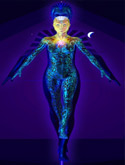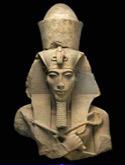I was recently asked if I had any information about the Southern Cross (the constellation known as Crux). Naturally, this set me on a whole train of thought on astronomical matters initially, only to find later that it tied in with one of my previous letters – the one on the Leo full moon and Sirius. This is not one of my usual letters in that it is more on astronomical matters than on astrological happenings. Instead, it is about the local universe of which we are a small part and about one of our fellow stellar Brethren of the Sirian system, which we know as Alpha Centauri. Everyone who lives in the Southern Hemisphere is well familiar with the ever-present Southern Cross in the night sky. But, as usual, there is more to this set of stars than meets the eye and, together with two of the stars in the constellation of The Centaur, form an important point of reference and a meditative station for anyone living in the southern climes.
Having grown up in a fairly populated part of the States, my view of the night sky was fairly obscured by all the artificial light in the neighborhood of my childhood and by the humidity and atmospheric conditions in that locale. I shall never forget, though, my first look at the night sky when I initially came to Australia and finally got away from the city. Going into the outback for the first time on a warm spring night I could only stand there transfixed in awe of the sheer multitudes and clarity of the stars stretched out before me, finally seeing with my own eyes constellations that I could only read about before. Australians will know well what I mean by this. You just cannot beat an outback sky, unless you live in the desert southwest of the US or in other remote desert or mountainous regions. The whole tapestry put me in mind of what the ancient astronomers would have been able to see every night away from villages and campfires. We miss out on so much in the cities in some respects.
Crux, or the Southern Cross, is the brightest constellation in the southern sky. It is also the smallest of the Western constellations. Together with the Southern Gate it contains 5 of the 28 visibly brightest stars in the sky, but more on that later. I am greeted by it every night when I walk out my front door. In the southern winter it is almost directly overhead in many parts of Australia, although people in the southern parts of the US would only just be able to see it on the horizon in their summer. European sailors have navigated by it for hundreds of years and have ascribed to it the most glowing accounts, due to its luminosity and thus its value as a navigational marker.
Crux used to be included in the constellation of the Centaur, being then the foot of the Centaur. It was separated from that constellation in the 1600s and was given its own place in the sky. With the stars Alpha and Beta Centauri it forms a pointer and a sort of clock hand in the heavens, indicating the seasonal changes in the year. They point roughly toward the galactic center in Sagittarius. In that capacity it performs the same function as the Great Bear did to the astrologers of ancient China for the Northern Hemisphere.
To the Chinese the Southern Cross and many of the stars in the Centaur formed their constellation of “The Arsenal”, the Cross being the “Arsenal Tower”, or “Heavenly Tower”. The stars Alpha and Beta Centauri were near the entrance into the Arsenal, and were known by themselves as “The Southern Gate”. The Southern Gate and most of the Arsenal are in the 1st Chinese lunar mansion, “The Horn”, and lay in a straight line of sight due south of the magnificent star Spica in the constellation of Virgo. That star marks the commencement of the Chinese Great Year of 12 years duration. So, there is much about all these stars and groupings concerned with commencements, gateways, directions and with preservation.
Of course, the aboriginal peoples of Australia have revered the Cross from time immemorial and have evolved many legends about it. The Boorung people of modern day Victoria called the Southern Cross “Bunya”, the possum, while the surrounding stars – specifically the Southern Gate and other stars in the Centaur– went to make up their “Tchingal”, the Emu. The Boorung legend runs thus:
Two brothers were chasing Tchingal, a very big and fast Emu from the spirit world. Tchingal moved so quickly that he scared Bunya, who ran up and hid in a tree. Bunya was also of the spirit world, but because of his cowardice, was changed into a possum, which always hides in the tops of trees (or in roof spaces in modern days). Tchingal and Bunya both escaped the hunters and live today in the night sky for all to see. In the sky, Tchingal is standing over Bunya, who cowers under Tchingal’s long neck. Some of the stars around Tchingal are the spears that the hunters threw at him. There are several variations upon this theme depending on which tribe is telling the story.
It is of interest to note the connection between the spears and the protective nature of the Emu and the trees with the Arsenal of the Chinese system. Arsenals are defensive, protective structures, too, although filled with weaponry. Of course, a cowardly possum is probably not what we would call the most flattering of symbols for such a magnificent grouping of stars. Perhaps a more palatable legend for Westerners (whitefellas, to use the aboriginal description of Westerners) would be that from the Noonuccal people of what is today called Stradbroke Island in the Torres Straits. It reads thus:
The Southern Cross was a special creation of the All-Father, Biame. It is a gum tree named Yaraando, which is called The Dreaming Tree of Life and Death. The Stars of the Cross are said to be the eyes of a man imprisoned in the tree, which blaze out through the darkness. The stars of the Southern Gate are said to be two white cockatoos which tried to follow the tree as it was lifted up to take its place in heaven. To the Noonuccal people it is a visible symbol of the hereafter and of the All-Father. I’ll bet I know which legend most of you will probably lean towards. We should keep in mind that the planets and stars in the heavens name themselves according to the nature of the people who connect with them.
When we begin to take a look at some of the more scientific data about the Southern Cross a very fascinating vista opens before us, for in this small part of the night sky some of the most dazzling and incredible objects are to be found. As was stated before, 3 of the stars in Crux are some of the brightest visual stars in the sky. Acrux, or Alpha Crucis, is the 14th brightest star, lying at 370 light-years from us. It is actually a binary system (2 stars), both stars of roughly the same size each. They are massive B-type stars of between 15 to 20 times the mass of our Sun. This is considered to be one of the very finest binaries in the heavens and they are separated by a distance of roughly six times the diameter of our solar system – a very bright solar system indeed.
Beta Crucis is the 20th brightest star in the sky with a mass of about 20 times our Sun. It is a pulsating star and lies at a distance of 490 light-years. Just to put these distances in perspective our parent system of Sirius is only a mere 10.8 light-years from us. The central pivot of our local universe – Alcyone in the Pleiades – lies at a distance of 400 light years. Gamma Crucis is a red giant star of about the same size as Alpha and Beta Crucis and is the 28th brightest star in the sky. It lies out at a distance of about 220 light years. Delta Crucis is another star like Alpha and Beta weighing in at about 15 Suns and at a distance of 570 light years. These are the 4 main stars which form the points of the cross. They are magnificent specimens in and of themselves. But wait, there’s more!
There is a very interesting cluster in Crux called the “Jewel Box”. It is what is termed a galactic cluster and is ranked among the finest objects in the southern Milky Way. The 50 or so brightest stars in the cluster are crammed into a space of no more than 25 light-years diameter. That would be like having 50 stars much brighter than our recent Mars spectacular ever-present in the night sky of one living in that part of the galaxy. They would drown out all but the brighter stars in that part of the universe, because some of those stars are more than 40 times the mass of our Sun, making them some of the most massive and luminous stars in our galaxy. To give some idea of brightness, the brightest of these stars is calculated to be around 80,000 times more luminous than our Sun, if you can imagine that. These stars are classed as supergiants and together form the core of one of the youngest clusters of stars known to us.
Ironically, just next to this brilliant sea of light lies one of the darkest and nearly starless areas of the galaxy, the “Coal Sack” Nebula. Nebulae are known as the birthplaces and graveyards of stars and planets – those areas of the heavens which can be compared to the darkness of the womb prior to birth and the grave after death. They are the places of gestation for stellar life and also the nurseries for young stars and planets of all types, as well as being the places where stars undergo their last gasps of life. But, that matter then gets used to create planetary life after the stars have thrown it off in death.
The Coal Sack is possibly the nearest nebula to us and lies just east of Alpha Crucis. It lies at a distance of 400-500 light years and is about 60-70 light-years in diameter. All of these stars just described and the Coal Sack are found within the boundaries of Crux Australis, the Southern Cross. Now, if we remember the aboriginal myth that called this constellation part of the Dreaming Tree of Life and Death, then we would have to take pause and wonder just what and how much the old fellas and their ancestors really knew about that part of the sky.
Continuing on with this, when we look at Beta Centauri–or Hadar, as it is also known – we again find another massive blue star. This one weighs in at about 20 solar masses and lies out at a distance of about 490 light-years. It is a binary system with a much smaller companion, possibly a solar “moon”. It is the 10th brightest star in the sky. This forms a part of the Chinese “Southern Gate” and is one of the pointers off the Southern Cross. It should be duly noted at this point that none of the stars just described is in any association with its constellational neighbors. All association is strictly illusory and “a trick of the light”.
But now we get to a star that we really will find of interest, for it is not so unlike our own Sun and it is our closest stellar neighbor in spaceAlpha Centauri or Rigel Kentaurus. Alpha Centauri is the 3rd brightest star in the sky, but it lies only 4.34 light years away. It is of the same spectral class as our Sun and only slightly larger. The surprise here is that it is actually a triple system, with two stars much like our Sun and a much smaller white dwarf star. The dwarf star is called Proxima Centauri and it orbits the main pair. Its mass is only 5%-15% that of our Sun. The Alpha Centauri system is considered to be another of the finest visual binaries in the heavens. The two main stars orbit eachother at a period of close to 80 years. They are in an elliptical orbit, varying at a distance of from 11 to 35 Astronomical Units (AU), where an AU is the diameter of our solar system, and were closest together (at periastron) in 1955.
The 3rd star, Proxima, takes about a half a million years to orbit the other two. Its orbital radius is a staggering 1/6 of a light year. It is also one of the faintest and least massive stars known to us. Added to this, as well, is the fact that it is what is known as a flare star, which means that it is highly unstable and evidences sudden changes in luminosity, at which time it emits massive solar flares. As such, it is a star in process of formation, and is thus in gestation. These flares occur at unpredictable intervals and may vary at up to a magnitude, only to return to normal in less than half an hour. It is among the most active of the flare stars and holds the record for the greatest number of observed outbursts. It almost puts one in mind of a fetus suddenly moving within the womb.
The Alpha Centauri system would have a very interesting planetary life and constituency, due to the changes in gravitational pull exerted by the binary pair. If we consider, though, that our Sun only appears as a bright star at the edge of our own solar system, then the presence of the companion star in the Centaurian system would almost go unnoticed, since the closest approach by the main companion star would be some 15 times the distance across our own solar system. The astrology of such a system would be most fascinating to a dweller in that system, with 3 Suns to consider. Since the two main Suns are very similar to our own it would give one pause to wonder what sort of lives and humanities are evolving in that most interesting of our sister solar systems.
I had stated in the Leo full moon/Sirius letter that there were many solar systems forming the greater Sirian system, with Sirius forming the focal point, or center. It is very likely there are at least several dozens of stars associated with that system, most of them smaller than our own. But, there are at least 10 systems in close proximity to us which are very much like our own solar system. Of these, Alpha Centauri is almost certainly one. There are also two other systems close to us that are triple systems, one of which is strongly suspected to have planets (61 Cygni). So, when we look at the pointers at the side of the Southern Cross it is no wonder we get drawn so strongly to them. The far one is our stellar neighbor and a member of our greater heavenly Brotherhood–so we feel at least a vague affinity to her.
I know this is a lot of “hard science” information and that it will mean little to some of you. It is more to make us all aware that we are far from alone in our little piece of heaven. Most of the grand Beings ensouling the massive stars in Crux and Beta Centauri have no compelling psychic connection with our immediate solar system. But, in terms of cosmic distances, even They are our close neighbors. It is analogous to living in a large city where certain great personages stand out, but we have no immediate relation to them, even though they will exert an influence on us in some manner or another. The main players in our Earth evolution from a stellar perspective are Sirius, the Great Bear, The Lesser Bear, the Pleiades, Betelgeuse, Aldeberan, Regulus, Castor and Pollux, the constellation of Draco (the Dragon), as well as the myriads of suns and their humanities which go to make up the constellations of our Zodiac.
In summary, we can see that there is so much locked away in the tiny constellation of Crux and the Southern Gate. It is a place in the heavens of the most intimate brotherhood, of the drama of life and death on a cosmic scale, of the most fantastic Being and of the minutest solar Life. There are a large number of Suns lesser than ours in that direction of space which are evolving in ways we cannot comprehend. There are many humanities there which would scarcely be recognizable as such to us as well as many that would be quite similar. Yet, they are all Divine, all fulfilling their own part in God’s Design and all one with us as a part of a greater Being. It is no wonder the Torres Strait Islanders called that region of space “The Dreaming Tree of Life and Death”. So, when we look upon the face of the Cross and the Gate, remember what the aboriginal Elders imparted to us regarding it. There is so much to explore – and so many lifetimes to do so!
Imprisoned in our bodies like the man imprisoned in the Yaraando tree, our Souls gaze out upon the vastness of creation – Dreaming. The dreams of our Souls are our own individual and collective Law. All moves and evolves, is born, lives and dies, according to the Dreaming of Beings greater than us. And, as reflections of God, we, too, dream – “Life is but a dream”, as the children’s song goes – hopefully, Merrily! Merrily! – definitely, Joyfully! Joyfully! For, life, as we know it, is but the sleep of our Souls. We are never more alive than when we get taken back to rejoin our ancestors after shedding our mortal coil. Just as we sleep each night and awaken refreshed in the morning, our dreams but the dim reflection of the greater livingness we experienced during the night hours, so our Souls re-awaken after our efforts in life with renewed vigor for the Work of God’s Plan and with the sure and certain knowledge of new qualities gained through our successful little strivings in this earthly realm. Yes, all our dreams do come true, eventually. May all your dreams come true as well!















I would love to see this as an illustrated book! What beautiful and miraculous concept for us to have access to. Any plans on making this a short story in book form?